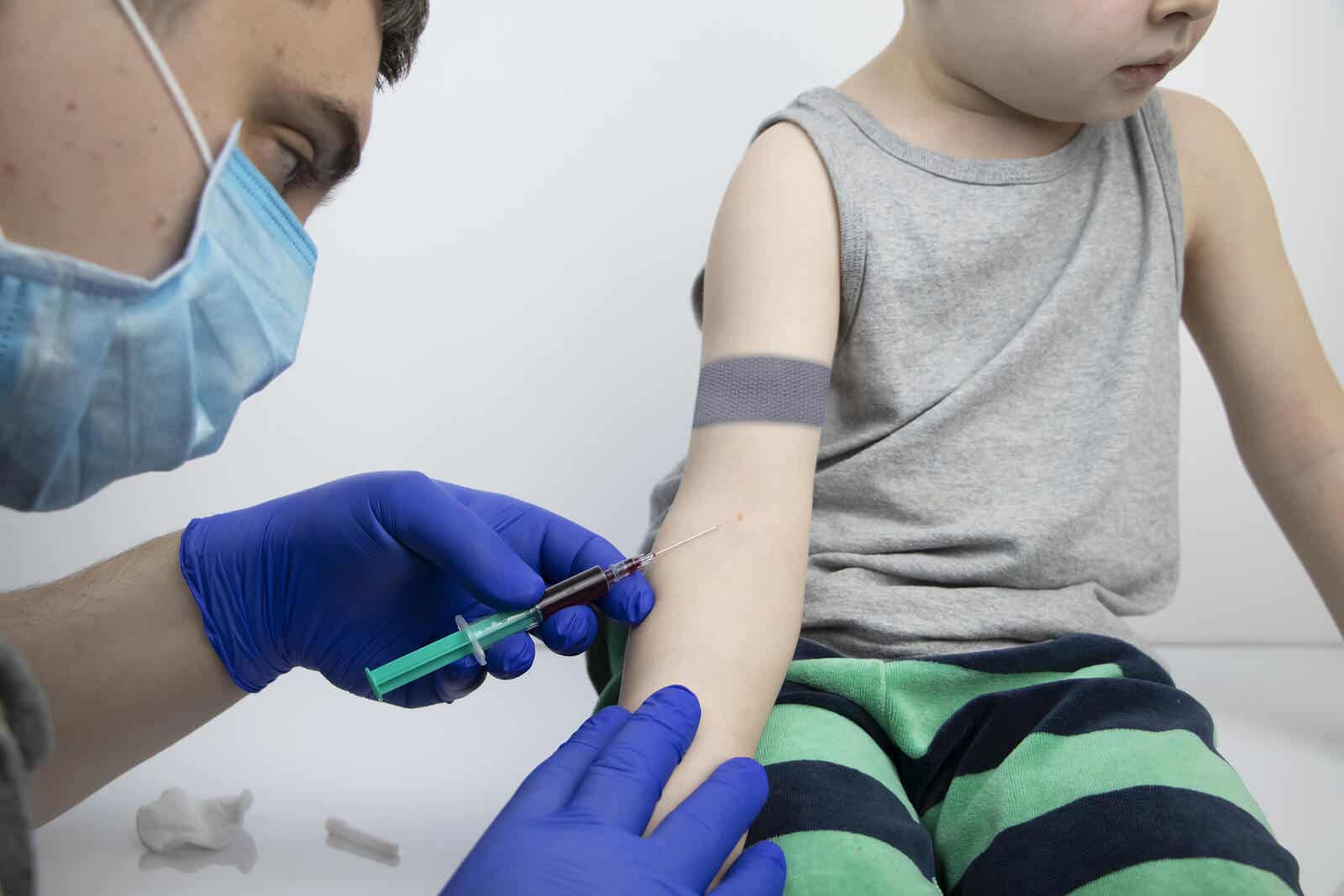Allergy Tests in Children: What Do They Involve?

Would you like to know what allergy tests in children involve? Allergies are characterized by an exaggerated reaction of the body to exposure to a certain substance. The body recognizes the substance as foreign by the body, thus activating the immune system abnormally. In severe cases, allergic reactions are capable of putting the patient’s life at risk.
Allergic rhinitis, urticaria, and bronchial asthma are just a few examples of diseases that allergic processes can explain. Fortunately, it’s possible to diagnose the tendency of children to develop these reactions thanks to various allergy tests. So, are you interested in knowing about them in-depth? Keep reading!
Types of allergy tests
Although skin tests are the most common and well-known, there are also other tests that allergists and other specialists (such as pulmonologists) use to help in the diagnosis of these conditions. Here are the most important ones!
Blood tests

Most blood tests that are useful in diagnosing allergies measure immunoglobulin E levels. This is a type of antibody that’s very important in allergic reactions and, if blood work reveals elevated levels, doctors will consider this a predisposition to develop allergic disorders.
There are many types of immunoglobulin E (as many as there are agents capable of developing an allergy in children), so blood tests usually look at two groups: Total IgE and specific IgE.
The former, as the name suggests, is the total of all these antibodies in the sample. The second, on the other hand, refers to the number of antibodies the body directs toward a particular agent.
Allergy skin tests
Skin tests are the most common and basically involve the injection of a small amount of the agent for which the specialist wants to measure a patient’s immune response. As they’re very low concentrations, in the vast majority of cases, there are no adverse reactions of any kind.
Respiratory functional tests
For the diagnosis of many diseases of the pulmonary system, pulmonologists make use of numerous studies such as spirometry. We refer to these collectively as functional respiratory tests. Their diagnostic utility ranges from asthma to chronic obstructive pulmonary disease (COPD), to name a few.
There are few cases in which these tests can diagnose an allergy as such. They help detect lung disease in any patient, whether or not they have allergies. For example, a spirometry test allows the diagnosis of bronchial asthma, which despite having an allergic component, isn’t the complete explanation of the disease.
Exposure, provocation, and tolerance tests
As the name suggests, these are studies that involve exposing the patient to certain substances to verify the body’s response. They must take place in health centers that have the means to deal with emergencies, but serious adverse effects are rare.
According to a publication of the Spanish Society of Clinical Immunology, Allergology, and Pediatric Asthma, there are several routes of exposure to these substances: oral, conjunctival, nasal, and bronchial.
Why are skin tests important?

You’re probably wondering why these tests are so famous and common, and this has to do very much with their practicality, low cost, and diagnostic specificity. Here are some of these reasons.
How and when do doctors perform skin tests?
The physicians in charge of performing this type of test are allergists. In most cases, a pediatrician refers patients to these specialists because they’ve developed bothersome or severe symptoms in certain conditions. For example, these may include bronchial asthma, allergic rhinitis, or frequent food allergies.
Therefore, the tests help diagnose and prevent certain conditions. In order to find out if your child needs it, go to your pediatrician and talk to them about these tests.
What if a test comes back positive?
Doctors consider tests are to be positive when a local lesion forms that’s characterized by enlargement, swelling, and redness. The largest diameter should be at least three millimeters.
In this case, the physician may offer preventive recommendations (especially with regard to diet) and treatments involving anti-histamines, immunomodulators, and steroids, depending on the patient’s particular case.
Advantages and disadvantages of testing
The prevalence of atopy in the general population is very high, a term that refers to the tendency to develop allergic reactions. For this reason, in a person with a history of allergies, it’s helpful to know which other substances they might react to in a similar way. Of course, this is very useful in the field of nutrition, as it helps to avoid unnecessary exposure to potentially life-threatening foods.
As for the drawbacks of the tests, the possibility of developing severe adverse reactions (including difficulty breathing, swelling throughout the body, and severe rashes) necessitates the involvement of medical specialists in centers trained to deal with emergencies.
Necessary and important tests for allergy detection
All these studies allow a better understanding of the state of health of children. Which in some severe cases must be accompanied by changes in lifestyle so that children can live their lives normally and safely. But the first step is diagnosis! Finally, if you have any doubts, go to your pediatrician or allergist, as they’ll know what to do.
Would you like to know what allergy tests in children involve? Allergies are characterized by an exaggerated reaction of the body to exposure to a certain substance. The body recognizes the substance as foreign by the body, thus activating the immune system abnormally. In severe cases, allergic reactions are capable of putting the patient’s life at risk.
Allergic rhinitis, urticaria, and bronchial asthma are just a few examples of diseases that allergic processes can explain. Fortunately, it’s possible to diagnose the tendency of children to develop these reactions thanks to various allergy tests. So, are you interested in knowing about them in-depth? Keep reading!
Types of allergy tests
Although skin tests are the most common and well-known, there are also other tests that allergists and other specialists (such as pulmonologists) use to help in the diagnosis of these conditions. Here are the most important ones!
Blood tests

Most blood tests that are useful in diagnosing allergies measure immunoglobulin E levels. This is a type of antibody that’s very important in allergic reactions and, if blood work reveals elevated levels, doctors will consider this a predisposition to develop allergic disorders.
There are many types of immunoglobulin E (as many as there are agents capable of developing an allergy in children), so blood tests usually look at two groups: Total IgE and specific IgE.
The former, as the name suggests, is the total of all these antibodies in the sample. The second, on the other hand, refers to the number of antibodies the body directs toward a particular agent.
Allergy skin tests
Skin tests are the most common and basically involve the injection of a small amount of the agent for which the specialist wants to measure a patient’s immune response. As they’re very low concentrations, in the vast majority of cases, there are no adverse reactions of any kind.
Respiratory functional tests
For the diagnosis of many diseases of the pulmonary system, pulmonologists make use of numerous studies such as spirometry. We refer to these collectively as functional respiratory tests. Their diagnostic utility ranges from asthma to chronic obstructive pulmonary disease (COPD), to name a few.
There are few cases in which these tests can diagnose an allergy as such. They help detect lung disease in any patient, whether or not they have allergies. For example, a spirometry test allows the diagnosis of bronchial asthma, which despite having an allergic component, isn’t the complete explanation of the disease.
Exposure, provocation, and tolerance tests
As the name suggests, these are studies that involve exposing the patient to certain substances to verify the body’s response. They must take place in health centers that have the means to deal with emergencies, but serious adverse effects are rare.
According to a publication of the Spanish Society of Clinical Immunology, Allergology, and Pediatric Asthma, there are several routes of exposure to these substances: oral, conjunctival, nasal, and bronchial.
Why are skin tests important?

You’re probably wondering why these tests are so famous and common, and this has to do very much with their practicality, low cost, and diagnostic specificity. Here are some of these reasons.
How and when do doctors perform skin tests?
The physicians in charge of performing this type of test are allergists. In most cases, a pediatrician refers patients to these specialists because they’ve developed bothersome or severe symptoms in certain conditions. For example, these may include bronchial asthma, allergic rhinitis, or frequent food allergies.
Therefore, the tests help diagnose and prevent certain conditions. In order to find out if your child needs it, go to your pediatrician and talk to them about these tests.
What if a test comes back positive?
Doctors consider tests are to be positive when a local lesion forms that’s characterized by enlargement, swelling, and redness. The largest diameter should be at least three millimeters.
In this case, the physician may offer preventive recommendations (especially with regard to diet) and treatments involving anti-histamines, immunomodulators, and steroids, depending on the patient’s particular case.
Advantages and disadvantages of testing
The prevalence of atopy in the general population is very high, a term that refers to the tendency to develop allergic reactions. For this reason, in a person with a history of allergies, it’s helpful to know which other substances they might react to in a similar way. Of course, this is very useful in the field of nutrition, as it helps to avoid unnecessary exposure to potentially life-threatening foods.
As for the drawbacks of the tests, the possibility of developing severe adverse reactions (including difficulty breathing, swelling throughout the body, and severe rashes) necessitates the involvement of medical specialists in centers trained to deal with emergencies.
Necessary and important tests for allergy detection
All these studies allow a better understanding of the state of health of children. Which in some severe cases must be accompanied by changes in lifestyle so that children can live their lives normally and safely. But the first step is diagnosis! Finally, if you have any doubts, go to your pediatrician or allergist, as they’ll know what to do.
All cited sources were thoroughly reviewed by our team to ensure their quality, reliability, currency, and validity. The bibliography of this article was considered reliable and of academic or scientific accuracy.
- Arruda E. Pruebas diagnósticas en alergia y su utilidad clínica. Rev Med Hered 2004;15(2):113-117.
This text is provided for informational purposes only and does not replace consultation with a professional. If in doubt, consult your specialist.








